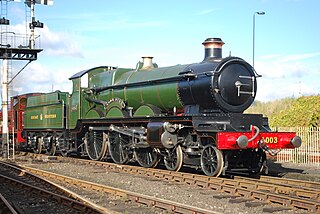
The Great Western Railway 4000 or Star were a class of 4-cylinder 4-6-0 passenger steam locomotives designed by George Jackson Churchward for the Great Western Railway (GWR) in 1906 and introduced from early 1907. The prototype was built as a 4-4-2 Atlantic. They proved to be a successful design which handled the heaviest long-distance express trains, reaching top speeds of 90 mph, and established the design principles for GWR 4-cylinder classes over the next twenty-five years.

The Great Bear, number 111, was a locomotive of the Great Western Railway. It was the first 4-6-2 (Pacific) locomotive used on a Great Britain railway, and the only one of its type built by the GWR.

The Great Western Railway 3700 Class, or City Class, locomotives were a series of twenty 4-4-0 steam locomotives, designed for hauling express passenger trains.
George Jackson Churchward was an English railway engineer, and was chief mechanical engineer of the Great Western Railway (GWR) in the United Kingdom from 1902 to 1922.

The GWR 4100 Class was a class of steam locomotives in the Great Western Railway (GWR) of the United Kingdom.

The Great Western Railway 3252 or Duke Class were 4-4-0 steam locomotives with outside frames and parallel domed boilers. They were built in five batches between 1895 and 1899 for express passenger train work in Devon and Cornwall. William Dean was their designer, possibly with the collaboration of his assistant, George Jackson Churchward. Four prototype 4-4-0s, of the Armstrong Class, had already been built in 1894.
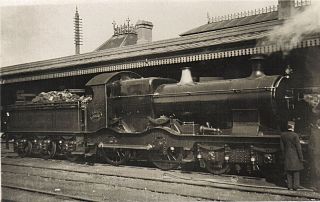
The Bulldog and Bird classes were double-framed inside cylinder 4-4-0 steam locomotives used for passenger services on the Great Western Railway. The Bird Class were a development of the Bulldogs with strengthened outside frames, of which a total of fifteen were built. A total of 121 Bulldogs were built new, with a further twenty rebuilt from Duke Class locomotives. Thirty Bulldogs were later rebuilt as Earl Class locomotives and renumbered 3265, 3200-3228.
The Great Western Railway 3800 Class, also known as the County Class, were a class of 4-4-0 steam locomotives for express passenger train work introduced in 1904 in a batch of ten. Two more batches followed in 1906 and 1912 with minor differences. They were designed by George Jackson Churchward, who used standard components to produce a four-coupled version of his Saint Class 4-6-0s.

The Great Western Railway 2900 Class or Saint Class was built by the Great Western Railway's Swindon Works. incorporated several series of 2-cylinder passenger steam locomotives designed by George Jackson Churchward and built between 1902 and 1913 with differences in the dimensions. The majority of these were built as 4-6-0 locomotives; but thirteen examples were built as 4-4-2. They proved to be a successful class which established the design principles for GWR 2-cylinder classes over the next fifty years.

The Great Western Railway (GWR) 6800 Class or Grange Class was a mixed-traffic class of 4-6-0 steam locomotive, built to replace the GWR 4300 Class 2-6-0. There were 80 in the class, all built at the Swindon works, using some reconditioned parts from withdrawn 4300 Class locomotives.

The Great Western Railway (GWR) 6000 Class or King class is a class of 4-6-0 steam locomotive designed for express passenger work and introduced in 1927. They were the largest locomotives built by the GWR, apart from the unique Pacific. The class was named after kings of the United Kingdom and of England, beginning with the then reigning monarch, King George V, and going back through history. They handled the principal GWR expresses on the main line from London to the West of England and on the Chiltern line to Birmingham and Wolverhampton, until 1962 when the class was withdrawn.
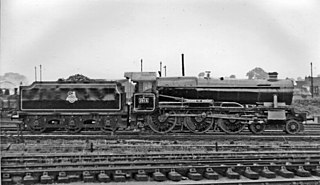
The Great Western Railway 1000 Class or County Class was a class of 4-6-0 steam locomotive. Thirty examples were built between 1945 and 1947, but all were withdrawn and scrapped in the early 1960s. A replica locomotive is under construction.

The Great Western Railway (GWR) 2301 Class or Dean Goods Class is a class of British 0-6-0 steam locomotives.

The Dean Single, 3031 Class, or Achilles Class was a type of steam locomotive built by the British Great Western Railway between 1891 and 1899. They were designed by William Dean for passenger work. The first 30 members of the class were built as 2-2-2s of the 3001 Class.
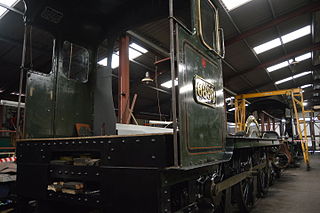
No.6880 Betton Grange is a steam locomotive which is under construction as a "new-build" project, originally based on the Llangollen Railway in Denbighshire, Wales, then subsequently at Tyseley Locomotive Works. Described as "building the 81st Grange", the project started in 1998, and the locomotive was earlier expected to be operational by 2013, but subsequently by Autumn 2021. All of the original GWR 6800 Class Grange locomotives were withdrawn for scrap by the end of 1965; this project is a creation, from an assemblage of original GWR and newly manufactured components, of a member of this class.
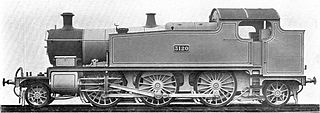
The Great Western Railway (GWR) GWR 5100 Class was a class of 2-6-2T side tank steam locomotives. It was the first of a series of broadly similar classes used principally for suburban passenger services.
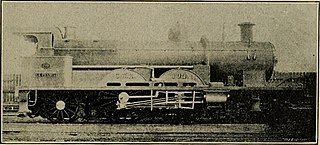
La France, number 102, was a locomotive of the Great Western Railway. It was bought by G.J. Churchward to evaluate French locomotive practice, and particularly the effect of compounding.

The Kruger Class was a series of exceptionally imposing-looking steam locomotives designed by William Dean and built at the Swindon Works of the Great Western Railway.
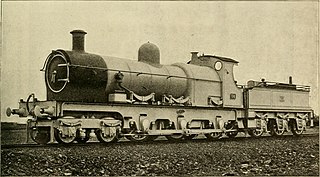
GWR No. 36 was a prototype 4-6-0 steam locomotive constructed at Swindon railway works for the Great Western Railway in 1896, the first 4-6-0 ever built for the GWR and one of the first in Britain. It was designed by William Dean and le Fleming comments that "the design is unusual and entirely Dean of the later period, including the only large boiler ever built entirely to his ideas."

The GWR 101 Class consisted of a single experimental 0-4-0 side-tank locomotive. It was built at GWR Swindon Works under the direction of George Jackson Churchward in June 1902.


















